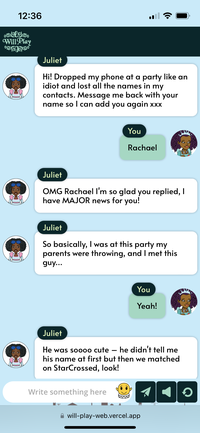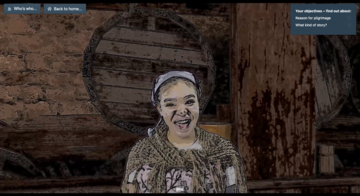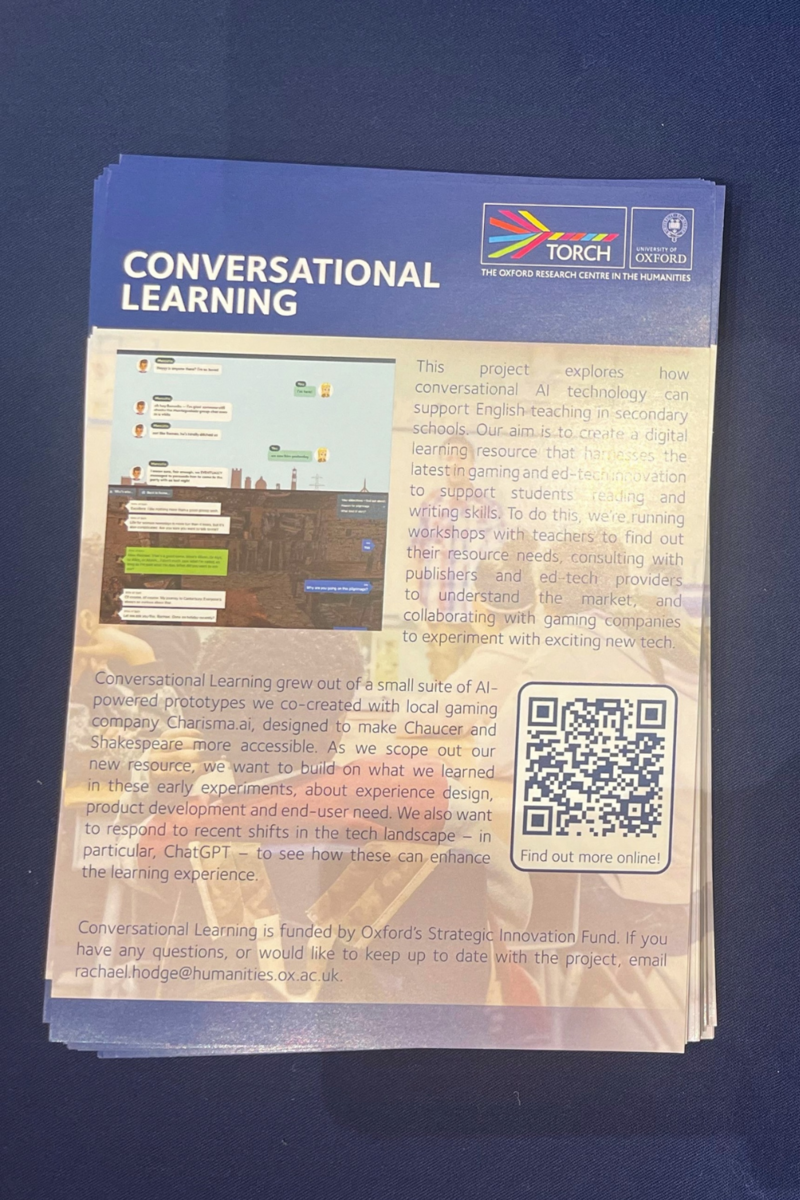Conversational Learning: One Year Down, One to Go
In their own ways, the ed-tech projects preceding Conversational Learning – WillPlay, Talking Objects, Virtual Canterbury Tales – all felt like sprints. We may have spent over a year in total developing WillPlay (our interactive re-telling of Romeo and Juliet), but we went from initial ideation meeting to MVP creation in a matter of weeks, and then successively refined the prototype in short bursts, applying for pockets of funding to iterate based on occasional user feedback and our own testing. Our interactive Roman-Egyptian shoe came to life over a single summer vacation, and Virtual Chaucer, like WillPlay, was developed and refined in phases. The bulk of our limited time on all these projects was spent making and re-making – on the reassuringly tangible output of the prototype itself.
It feels a little strange, therefore, to be reflecting at the half-way point of Conversational Learning, with one whole year of the project elapsed and no working prototype to show for it. We could have built WillPlay several times over in the past 12 months, perhaps adapting Macbeth and The Tempest as companion pieces to Romeo and Juliet. Rather than simply iterating on the same message-based format, however, we wanted to use the time afforded by our SIF-funded project to understand if and how this format was working for our envisaged end users. So although we haven’t made anything new in the past year, we’ve learned a lot! Across three teacher workshops, a series of stakeholder interviews and some outsourced market scoping consultancy, we’ve found out a huge amount about our end-user need that we’re now ready to incorporate into an updated resource. Here, we wanted to share three of our headline findings.

A screenshot of WillPlay being played on mobile.
A surfeit of Shakespeare
When we first made WillPlay – before it was even called WillPlay! – we decided to focus our resource on Shakespeare not only because his plays are familiar and widely studied, but because they seem to lend themselves to playful adaptation, having been re-imagined so many times already. This meant, however, that we were entering into a saturated market. Major cultural institutions from the Globe to the BBC have already produced whole series of Shakespearean resources; no WhatsApp-style retellings of Romeo and Juliet, admittedly, but enough to keep teachers and students well supplied with content all the same! Moreover, we heard from some teachers that WillPlay takes on the part of teaching they enjoy most, encouraging students to inhabit the text and draw out contemporary references. Almost all the teachers we spoke to liked WillPlay as a resource – but they didn’t need it.
Less is more
With technology developing faster than ever before, it’s tempting to try to throw everything at new digital experiences: VR compatibility, metaverse integration, images and videos generated in real-time by AI. But while this kind of technological upselling works well in other sectors, we’ve learned that, when it comes to education, less is definitively more. School budgets are stretched, and hardware provision is consequently limited. Although the pandemic supercharged a transition to digital learning, there are schools that are now rolling back these changes; some institutions that adopted Chromebooks, for example, are now reverting to pen and paper, as broken laptops prove too costly to replace. We need our resource to be technologically undemanding, at least from a user perspective. Ease of logging in, speed of internet, processing power of PCs: we must do everything we can to prevent these from becoming barriers to use.
Creativity is key

A screenshot from Virtual Canterbury Tales, which included performances from Oxford-based theatre company Creation Theatre.
What we expected to hear from teachers is that our existing digital resources focus too much on providing entertaining, creative explorations of a text at the expense of clear learning objectives: they don’t output enough useful assessment data. And, to some extent, this is what teachers told us in our workshops. When we proposed solutions that more closely resembled straightforward quiz- or exam-style experiences, however, lots of the teachers we were working with pushed back. With schools and students under so much pressure to meet assessment objectives, master exam techniques and achieve pass grades in core subjects, creative activities and pursuits are often sidelined. Teachers wanted a resource that encouraged students to think and express themselves in original ways, rather than falling back on rote-learned phrases. We were delighted to hear this, of course, but it poses a challenge: how do we retain our creative approach while aligning the resource more clearly with curriculum learning objectives?
We’ve come a long way over the past 12 months, and although we haven’t yet started making our Conversational Learning resource, we have a much clearer sense of what it needs to do to solve real problems for teachers and schools. Over the coming months, we’ll be translating everything we’ve learned into a brand-new digital prototype – with lots of testing and teacher consultation along the way! What exactly will that prototype look like, and how will it work? Watch this space to find out – and, if you'd like to find out more about the project, contact rachael.hodge@humanities.ox.ac.uk with any questions!

A Conversational Learning leaflet from a conference earlier this year.


